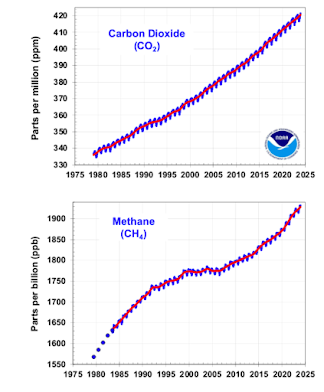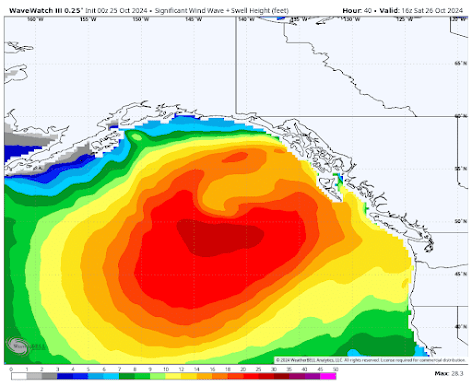This week I fielded a call from a reporter from the Washington Post, who wanted to discuss why the U.S. has fallen behind in using machine learning for weather prediction. The story is here.
The reporter only had half the story: traditional U.S. global weather prediction models, which solve the complex equations that describe atmospheric physics, have declined into mediocrity.Specifically, NOAA's global model, the UFS, is now in third or fourth place behind the European Center, the UK Meteorology Office, and often the Canadians. The plot below shows a comparison for the middle troposphere (at a pressure of 500 hPa) between the European Center and the NOAA. We are behind and not catching up.
But it is even worse than this. The European Center is actively pushing AI/ML (Artificial Intelligence/Machine Learning) numerical weather prediction, with their efforts producing even more skillful predictions. NOAA is hardly trying.To put it bluntly, U.S. operational prediction is being left in the dust. We have settled into mediocrity with little hope of change.
This is entirely unnecessary and I can tell you why. I have written two peer-reviewed papers in a major meteorological journal (here) and have served on national committees and attended numerous meetings considering the issue.
U.S. numerical weather prediction (NWP), which uses computer simulation to predict future weather, should be the best in the world.
Our nation invented the technology and led the world for decades. We have the largest meteorological research establishment in the world and spend more money on weather prediction than any nation. Our private sector invented machine learning numerical weather prediction.
The United States should be far ahead of the rest of the world in a technology that saves lives, promotes our economy, and has great strategic value. But we are not.
As you will see, this unfortunate situation results from ineffective government bureaucracy, isolation of government weather prediction from the creative energy of the university community, and too much money leading to multiple duplicative efforts, among other reasons.
Reason Number One: U.S. numerical weather prediction is spread over too many agencies
In most nations, numerical weather prediction is the responsibility of one group. In the U.S., governmental global weather prediction is spread over FIVE efforts:
- NOAA, the National Oceanographic and Atmospheric Administration (the leading U.S. effort)
- The US Navy
- The US Air Force
- NASA
- U.S. Department of Energy
Thus, scientific and technical talent and computer resources are diffused over five groups, greatly undermining progress.
But it is worse than that. Another independent (and important) independent NWP development is found at the National Center for Atmospheric Research, the combined effort of the university community. Government agencies have generally not taken full advantage of such university research and development.
The private sector also has major global weather prediction efforts, such as those run by IBM/WeatherChannel and several high-tech firms developing AI prediction systems. With national resources divided, with relatively little cooperation and few joint efforts, U.S. progress in global weather prediction has trailed behind other nations and the state of the science.
Reason 2: NOAA Organization of NWP is Flawed
The central U.S. agency responsible for operational numerical weather prediction is NOAA, of which the National Weather Service is a component. In NOAA, no single individual has overall responsibility for
the success of U.S. operational numerical weather prediction.
Today, the NWS Environmental
Modeling Center (EMC) director, who is responsible for running NOAA forecast models does not control model development, which is found outside the National
Weather Service in NOAA OAR (ESRL, GFDL, and NSSL labs). Funding for model development
initiatives, and particularly the support of extramural modeling research, is
found in both the National Weather Service Office of Science Technology
Integration (OSTI) and the NOAA OAR Weather Program Office (WPO), not by the
leadership of EMC.
This division
of responsibility and resources has led to competing efforts, wasted
resources, and occasionally unproductive conflicts and tensions.NOAA management has also made some very poor decisions that have undermined progress. For example, 8 years ago, realizing their global modeling system needed to be replaced, NOAA management decided to use an in-house system (FV-3) instead of a modeling system developed by the academic community (NCAR's MPAS).
Refusing to complete extensive testing and rejecting warnings about FV-3 (that it failed to accurately simulate convection...e.g., thunderstorms), they adopted FV-3. As predicted, the model flaws became apparent in recent years and NOAA is being forced to abandon FV-3. The result is the loss of nearly a decade of effort and tens of millions of dollars of public funds.
Reason 3: Lack of Cooperation and Joint Research and Development with the Academic Community
As noted above, NOAA rejected the the well-tested model developed by the university community, called MPAS. Today, they are being forced to reconsider that decision and recently announced they will use MPAS for regional applications, but have been silent regarding global prediction.
But NOAA's refusal to work with the large university community is more clearly shown by the story of the EPIC center. In 2017 Congress passed the Weather Research and Forecasting Innovation Act,
followed by the National Integrated Drought Information System Reauthorization Act of 2018,
which established an Earth Prediction Innovation Center (EPIC).
It was hoped that EPIC could
become an independent, national center for model development and innovation, bringing together the academic, governmental, and private-sector communities. Unfortunately, NOAA downgraded EPIC into an entity centered on code maintenance and support, not the independent national development center visioned by Congress. A major defense contractor with no experience in weather prediction was given the contract (Raytheon).
To put in politely, EPIC is recognized as a failure.
Reason 4: Inadequate computer resources.
U.S.
operational NWP has historically suffered from a lack of computer resources,
often with far less computational capability than competitors with lesser
requirements (e.g., ECMWF). A decade
ago, during the landfall of Hurricane Sandy, NOAA/NWS/NCEP operational NWP
computers only had a peak capacity of 0.1 petaflops, roughly one-tenth of that
available to ECMWF, which possessed a far more limited NWP portfolio. Although
NOAA/NWS has recently acquired significant computer upgrades, it possesses
only a fraction of the computer resources it could productively use in
operational NWP. Furthermore, there is
a profound shortage of computing resources for supporting research.
High-resolution global prediction (grid spacing of 3 km or less) could revolutionize weather prediction, producing far more skillful forecasts, but NOAA has no plans to secure the computing resources necessary to make this happen.
The Department of Energy is able to acquire vast computing resources hundreds of times greater than NOAA. NOAA needs access to such computing capabilities to help protect and warn the American people.
How the U.S. Could Have the Best Global Weather Prediction Within A Few YearsIf the new Congress and President wish for the U.S. prediction effort to gain world leadership within a few years, this is how to do it:
1. Establish an EPIC center outside of NOAA, that will be an independent national center to develop and test the best global weather prediction models in the world. Many of the critical pieces are available today: the NCAR MPAS global model and the JEDI data assimilation infrastructure. This will be a multi-agency effort with the active participation of NCAR and the university community.
2. Move all forecast model development, support, and operations in NOAA into ONE entity, with one person being responsible.
3. Secure at least 100 times the current computer resources for forecast model development and operations.
4. As part of the EPIC effort, actively evaluate and test ML-based prediction approaches, with close cooperation with American tech firms that are already active in this field. Develop operational ML weather prediction systems, as well as hybrid approaches with physics-based models.
In five years we could easily be the best in the world.




















.gif)
































